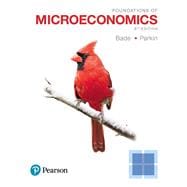An engaging, practice-oriented approach to understanding core economic principles
Foundations of Microeconomics, 8th Edition introduces readers to the economic principles they can use to navigate the financial decisions of their futures. Each chapter concentrates on a manageable number of ideas, usually 3 to 4, with each reinforced several times throughout the text. This patient approach helps guide individuals through unfamiliar terrain and focus them on the most important concepts.
The text does four core things to help readers grasp and apply economic principles: it motivates with compelling issues and questions, focuses on core ideas, offers concise points, and encourages learning with activities and practice questions. After completing this text, readers will have the foundational knowledge of how the economy works and can apply it to their lives going forward.
Also available with MyLab Economics
MyLab™ Economics is an online homework, tutorial, and assessment program designed to work with this text to engage students and improve results. Within its structured environment, students practice what they learn, test their understanding, and pursue a personalized study plan that helps them better absorb course material and understand difficult concepts.Note: You are purchasing a standalone product; MyLab Economics does not come packaged with this content. Students, if interested in purchasing this title with MyLab Economics, ask your instructor for the correct package ISBN and Course ID. Instructors, contact your Pearson representative for more information.
If you would like to purchase both the physical text and MyLab Economics, search for:
0134668650 / 9780134668659 Foundations of Microeconomics Plus MyLab Economics with Pearson eText -- Access Card Package, 8/e
Package consists of:
- 013449198X / 9780134491981 Foundations of Microeconomics
- 013451842X / 9780134518428 MyLab Economics with Pearson eText -- Access Card -- for Foundations of Microeconomics











